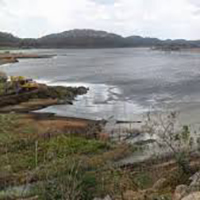Spatio-temporal variation of cyanobacteria and cyanotoxins in public supply reservoirs of the semi-arid region of Brazil
Cyanobacteria and cyanotoxins in reservoirs of the semi-arid region

Accepted: 16 September 2019
HTML: 151
All claims expressed in this article are solely those of the authors and do not necessarily represent those of their affiliated organizations, or those of the publisher, the editors and the reviewers. Any product that may be evaluated in this article or claim that may be made by its manufacturer is not guaranteed or endorsed by the publisher.
Authors
Cyanobacteria harmful algal blooms (CyanoHABs) have become increasingly frequent and intense in public supply reservoirs as a result of eutrophication and global climate change. The semi-arid region of Brazil has a well documented history of CyanoHABs but the underlying factors that control the excessive proliferation of these organisms and the production of their bioactive secondary metabolites are not comprehensively understood. This study aimed to identify the environmental factors that explain the spatial and temporal variations in the abundance of cyanobacteria and the concentration of cyanotoxins (microcystins, saxitoxins, and cylindrospermopsin) in semi-arid reservoirs. The following hypotheses were tested: (a) the largest biovolumes of potential toxin producing cyanobacteria occur when cyanotoxin concentrations are highest; and (b) the environmental factors that explain variations in biovolume of cyanobacteria also explain changes in cyanotoxins concentrations. Samples were taken from four reservoirs located in the Northeast region of Brazil, over a three-month period (October 2016 and February and June 2017). Of the 24 species of cyanobacteria identified, 13 were potentially toxin-producing. Physicochemical variables such as water volume of the reservoir, water transparency, soluble reactive phosphorus, and total phosphorus explained the abundance of cyanobacteria and the levels of cyanotoxins. These results corroborate the hypothesis that similar physicochemical conditions influence the abundance and diversity of cyanobacteria and cyanotoxins. Cyanobacterial blooms composed of more than one potential toxin producing species were observed in the studied reservoirs, where potential microcystin-producing species were the most common. Microcystins and saxitoxins were detected in all the reservoirs studied, while cylindrospermopsin and the cyanobacterium Cylindrospermopsis raciborskii were simultaneously recorded in only one reservoir (Camalaú Reservoir). Cylindrospermopsin was only detected in a reservoir for the first time in the State of Paraíba. Canonical redundancy analysis showed that the cyanotoxins were related to potential toxin producing species. These results corroborate the proposed hypothesis that there is a correlation between cyanotoxins and the biomass of potential producers. Also, there were situations where cyanotoxins were detected without the presence of potential producers. These results demonstrate the need for reassessment of potential toxin producing species of cyanobacteria in semi-arid reservoirs. This may lead to the identification and characterization of novel producers of these bioactive secondary metabolites.
Edited by
Andrea Lami, CNR-IRSA Verbania, ItalyHow to Cite
Similar Articles
- Camilla Capelli, Federica Mauri, Elisa Pianta, Federica Rotta, Fabio Lepori, Environmental DNA survey indicates arrival of quagga mussel in Ticino River basin , Journal of Limnology: Vol. 82 (2023)
- Silvia Quadroni, Alex Laini, Francesca Salmaso, Livia Servanzi, Gaetano Gentili, Serena Zaccara, Paolo Espa, Giuseppe Crosa, Towards ecological flows: status of the benthic macroinvertebrate community during summer low-flow periods in a regulated lowland river , Journal of Limnology: Vol. 81 No. s2 (2022): Effects of water level management on lake littorals and downstream river areas
- Yajun Xie, Yonghong Xie, Cong Hu, Xinsheng Chen, Feng Li, Interaction between litter quality and simulated water depth on decomposition of two emergent macrophytes , Journal of Limnology: Vol. 75 No. 1 (2016)
- Michelle C. LIMA, Marcelo F.L. SOUZA, Gilmara F. EÇA, Maria A.M. SILVA, Export and retention of dissolved inorganic nutrients in the Cachoeira River, Ilhéus, Bahia, Brazil , Journal of Limnology: Vol. 69 No. 1 (2010)
- Diane M. Orihel, Rebecca C. Rooney, A field-based technique for sediment incubation experiments , Journal of Limnology: Vol. 71 No. 1 (2012)
- Letizia GARIBALDI, Valeria MEZZANOTTE, Maria Cristina BRIZZIO, Michela ROGORA, Rosario MOSELLO, The trophic evolution of Lake Iseo as related to its holomixis , Journal of Limnology: Vol. 58 No. 1 (1999)
- Roberta Piscia, Simone Tabozzi, Roberta Bettinetti, Liisa Nevalainen, Marina M. Manca, Unexpected increases in rotifer resting egg abundances during the period of contamination of Lake Orta , Journal of Limnology: Vol. 75 No. s2 (2016): Lake Orta: a new lease on life
- Cristian Scapozza, Nicola Patocchi, Lake Maggiore: geomorphological genesis, lake-level evolution, and present and future ecosystems importance , Journal of Limnology: Vol. 81 No. s2 (2022): Effects of water level management on lake littorals and downstream river areas
- Michela ROGORA, Letizia GARIBALDI, Giuseppe MORABITO, Silvia ARISCI, Rosario MOSELLO, Present trophic level of Lake Alserio (Northern Italy) and prospect for its recovery , Journal of Limnology: Vol. 61 No. 1 (2002)
- Marco Pilotti, Stefano Simoncelli, Giulia Valerio, Computing the transport time scales of a stratified lake on the basis of Tonolli’s model , Journal of Limnology: Vol. 73 No. 3 (2014)
<< < 23 24 25 26 27 28 29 30 31 32 > >>
You may also start an advanced similarity search for this article.
-
Juliana dos Santos Severiano, Edlayne Rayanara Pontes de Lima, Daniely de Lucena-Silva, Dayrla Kelly Gomes Rocha, Maria Eduarda Santana Veríssimo, Bruno Renaly Souza Figueiredo, José Etham de Lucena Barbosa, Joseline MolozziWater Research : 2023
-
Thiago Santos de Almeida Lopes, Amanda Myrna de Meneses e Costa, Whelton Brito dos Santos, Weruska Brasileiro Ferreira, Patricia Herminio CunhaCadernos Técnicos Engenharia Sanitária e Ambiental : 2023
-
Ranielle Daiana dos Santos-Silva, Juliana dos Santos Severiano, Mathias Ahii Chia, Tatiane Medeiros Queiroz, Micheline Kézia Cordeiro-Araújo, José Etham de Lucena BarbosaEnvironmental Pollution : 2024
-
Flávia Morgana Monteiro, Gustavo Correia de Moura, Juliana dos Santos Severiano, Camila Ferreira Mendes, José Etham de Lucena BarbosaAquatic Ecology : 2021
-
Andreia Souza Regis, Ronaldo Faustino da Silva , Fabio Henrique Portella Corrêa de Oliveira, Eduardo José Alécio de OliveiraRevista de Gestão Social e Ambiental : 2024

 https://doi.org/10.4081/jlimnol.2019.1893
https://doi.org/10.4081/jlimnol.2019.1893





